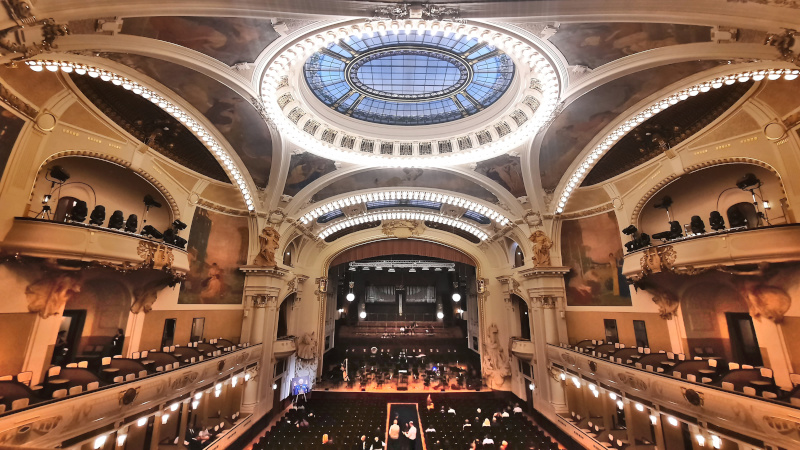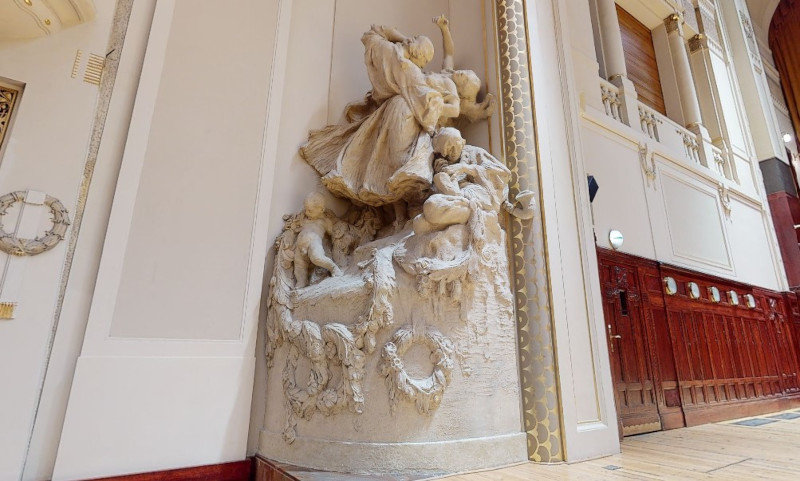Smetana Hall
All guidebooks about Prague will mention the Municipal House but the Smetana Hall inside the building gets much less coverage probably because it’s not a place that you can just walk into. Strange, when you think that the Smetana Hall was to be the beacon of the celebration of Slavic culture and the Municipal House was designed around it.

What’s Special about Smetana Hall?
As well as being the largest classical concert hall of it’s time with a capacity of 1200 spread over two balcony floors and the stalls it really is a who’s who of artists from the period. The name “Smetana Hall” comes from the famous Czech composer Bedrich Smetana, recognised as the creator of the “modern” Czech Music (modern for the 1860s). He had died in 1884, 18 years before building work began.
The Municipal House in which the Smetana Hall is located contains some of the most stunning Art Nouveau decoration and historical Slavic cultural art. The Smetana Hall decoration aligns itself specifically to the history of music and the arts.
The Death of Antonín Dvorák
Ask people to name a list of Czech composers and I’m certain that both Bedrich Smetana and Antonín Dvorák would be on it. Whereas the original decorative plans for the Smetana Hall were to revolve around the works of Smetana, the death of Antonín Dvorák in 1904 changed those plans.
Either side of the stage area are two huge stucco statues by the most famous sculptor of the day called Ladislav Šaloun. As you face the stage the right side features a representation of Smetana’s composition called “Vyšehrad” where a man narrates the story of the Slavic homeland accompanied by a harp. It was the first of a set of six symphonic poems which formed a work called “My Country” that celebrated Slavic culture (Note: Smetana never heard it played as he was completely deaf when he wrote it in 1874).

As you face the stage on the left side is the white stucco statue which is the representation of the 1878 musical work by Antonín Dvorák called “Slavonic Dances” (the statue with the dancing couple pictured above). This represents the melodic, harmonic and rhythmic patterns of Slavic folk dances.
The first-floor box balcony and the upper balcony level is also decorated with motifs and profiles of a selection of other less well-known Czech composers.
Other forms of art are also captured in wall and ceiling murals including Karel Spillar’s huge murals called Music, Poetry, Dance and Drama which are located on the side walls above the balcony level.
Getting Into the Smetana Hall
There are two ways to enter the Smetana Hall. The most popular is just to buy tickets for any performance. It is a classical concert hall but I’ve been here for international cultural festivals, big-band jazz and even a night celebrating the Beatles. Be sure to dress for it. The other way is to do the Official Tour of the Municipal House which includes Smetana Hall.
Something Related or a Few Minutes Away
Activity – Official Municipal House Tour
Festivals – Prague Spring International Music Festival
Entertainment – Hybernia Theatre
Services – Palladium Shopping Centre
Legends – The Darth Vader Statue
